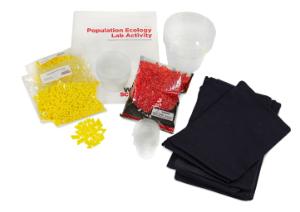Key Concepts of Biodiversity; Plus a free handout from AccessScience
Access to this content is available to Ward’s World readers for free from McGraw Hill’s AccessScience, an award-winning, digital STEM resource that provides immediate, authoritative answers to students’ thirst for scientific knowledge on topics such as climate change, virology, pollution, and more. Ward’s World and McGraw Hill have partnered to offer educators a no-obligation, free trial subscription to this product. Request your free trial today and discover how valuable AccessScience can be for you and your students.
High School
Biodiversity (biological diversity) refers to the wide variety of life on Earth, from genes and species to ecosystems. This concept includes the evolutionary, ecological, and cultural processes that sustain life. The key here is knowing everything is interconnected and dependent on everything else!
Your biodiversity lesson plans can help students investigate the fragile interdependence between species and ecosystems. Students can explore how small changes can have significant consequences. Bees are a great example. The vital role bees play in our daily lives means it’s crucial that we understand the butterfly effect caused by collapsing bee colonies.
Let’s explore what all the buzz is about.
In Get the Buzz on Pollination, we discuss bees and other pollinators responsible for a third of the world's crops, including many of the fruits and vegetables we eat. However, bee populations have been declining rapidly in recent years as their colonies are collapsing at an alarming rate. Students may be curious about some of the factors that impact the collapse of bee colonies. The collapse of bee colonies is a complex issue with many potential causes.
When it comes to the essential facts to get them started, this list is the bee’s knees!
Agricultural Practice Impact on Bees
One of the main contributors to this problem is the widespread use of pesticides (specifically neonicotinoids1) in agriculture. While these chemicals protect crops from pests, they can also harm bees needed for pollination. Bees are also exposed to pesticides when foraging for food or landing on contaminated surfaces near their hives.
Monoculture farming is a form of agriculture that is based on growing only one type of crop at one time in a specific field. This reduces the variety of plants and flowers essential for bee survival.
Climate Change Impact on Bees
Climate change is also having an impact on bee populations. Rising temperatures and changes in weather patterns can disrupt plants’ flowering and pollination cycles, affecting bees' ability to collect pollen and nectar. The ten warmest years in the historical record have all occurred since 2010.2 Extreme weather events, such as droughts or floods, can also destroy bees' habitats, making it harder for them to survive and reproduce.
Human Expansion Activities Impact on Bees
The loss of their habitat is another major factor contributing to the decline of bee populations. Bees thrive best in gardens, woodlands, orchards, meadows, and other areas with lots of flowering plants. Unfortunately, with the expansion of urban and agricultural areas, natural habitats for bees are being destroyed. This habitat loss makes it harder for bees to find food, shelter, and suitable breeding sites, leading to a decline in their numbers.
Your lesson plan can help students explore how each of these factors demonstrates life’s interdependencies and play a key role in disrupting biodiversity, especially for our friends, the bees.
Lack of public awareness of biodiversity conservation is the leading cause of biodiversity loss.3 So, before anyone gets a bee in their bonnet about the collapsing bee colonies, there are ways to help save them. Get busy taking these steps:
- Plant bee-friendly plants. Bees are attracted to plants that produce a lot of pollen and nectar, such as lavender, sunflowers, and wildflowers.
- Avoid using pesticides in your garden or home. Instead, use natural pest control methods, such as companion planting or handpicking pests.
- Support local farmers who use sustainable and bee-friendly farming practices. Look for labels such as "organic" or "bee-friendly" when shopping for produce.
- Spread the word about the importance of bees and the challenges they face (hint: share this post). Talk to your friends, family, and community about bees' role in our food system and how we can help protect them. Additionally, your lesson plan is vital to educating the next generation about the declining bee population’s significance. Students may be inspired to help protect and support these vital pollinators as they learn the science.
Download McGraw Hill's AccessScience article, Biodiversity, covering mathematical concepts, global species analysis, and the impact of human activities. The free download also includes assessment questions and answers you can use to test student understanding.
1. Xerces Society Invertebrate Conservation: How Neonicotinoids Can Kill Bees 2. National Oceanic and Atmospheric Administration: Climate Change: Global Temperature 3. Ibrahim MSN, Assim MISA, Johari S, Mohammad SKW, Afandi SHM, Hassan S. Public awareness on biodiversity conservation and well-being.
Recommended Products
[StartProductBlock]

Ward's® Biodiversity: Exploring the World Around You Lab Activity
Students explore the diversity in their own backyard ecosystem. Linked to a real-world scenario and Includes a teacher's guide.
[EndProductBlock]
[StartProductBlock]

Ward's® Ecosystems in Distress: Oil Spill Cleanup Lab Activity
Engage students in addressing real-world issues by investigating environmental science, biotechnology, and socio-economics.
[EndProductBlock]
[StartProductBlock]

Ward's® Engage Population Ecology, IBL Case
Students act as researchers studying global predator-prey population dynamics to understand matter and energy transfers in ecosystems in the process.
[EndProductBlock]
